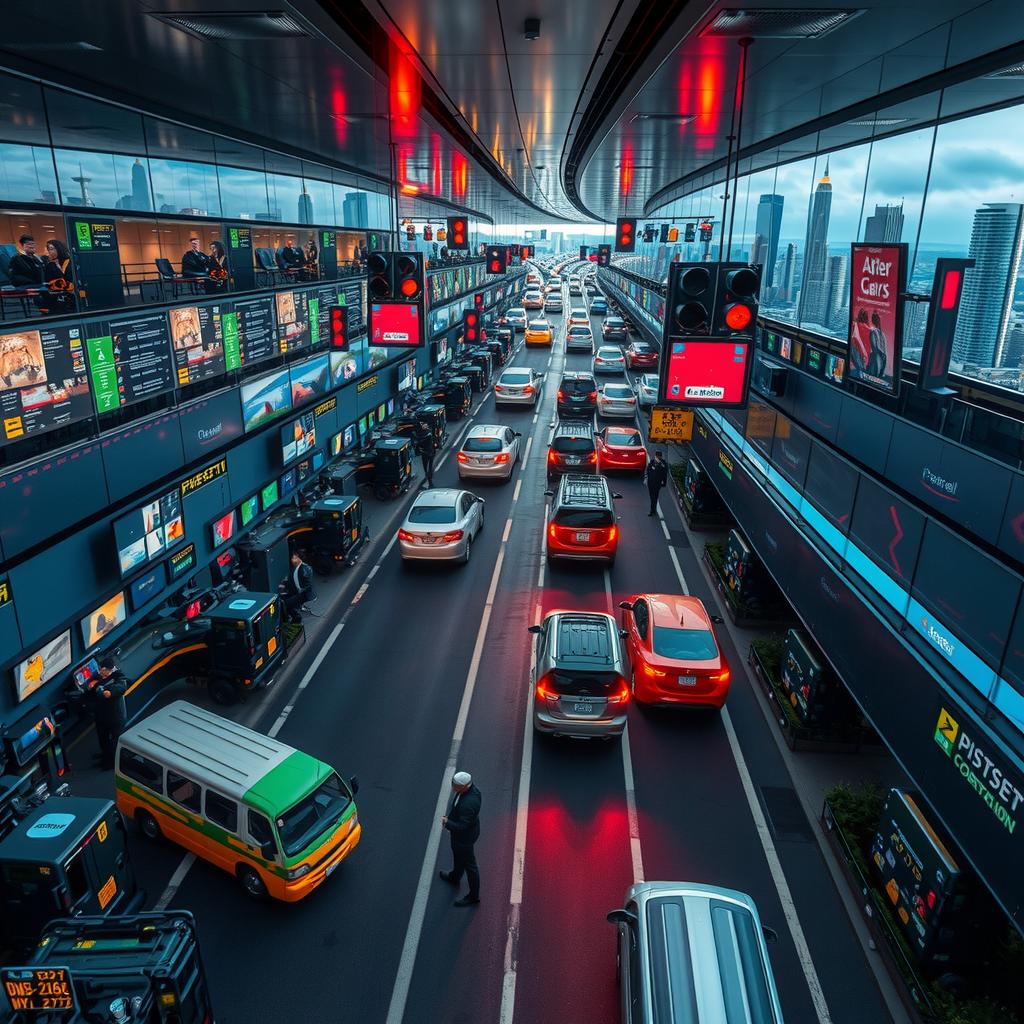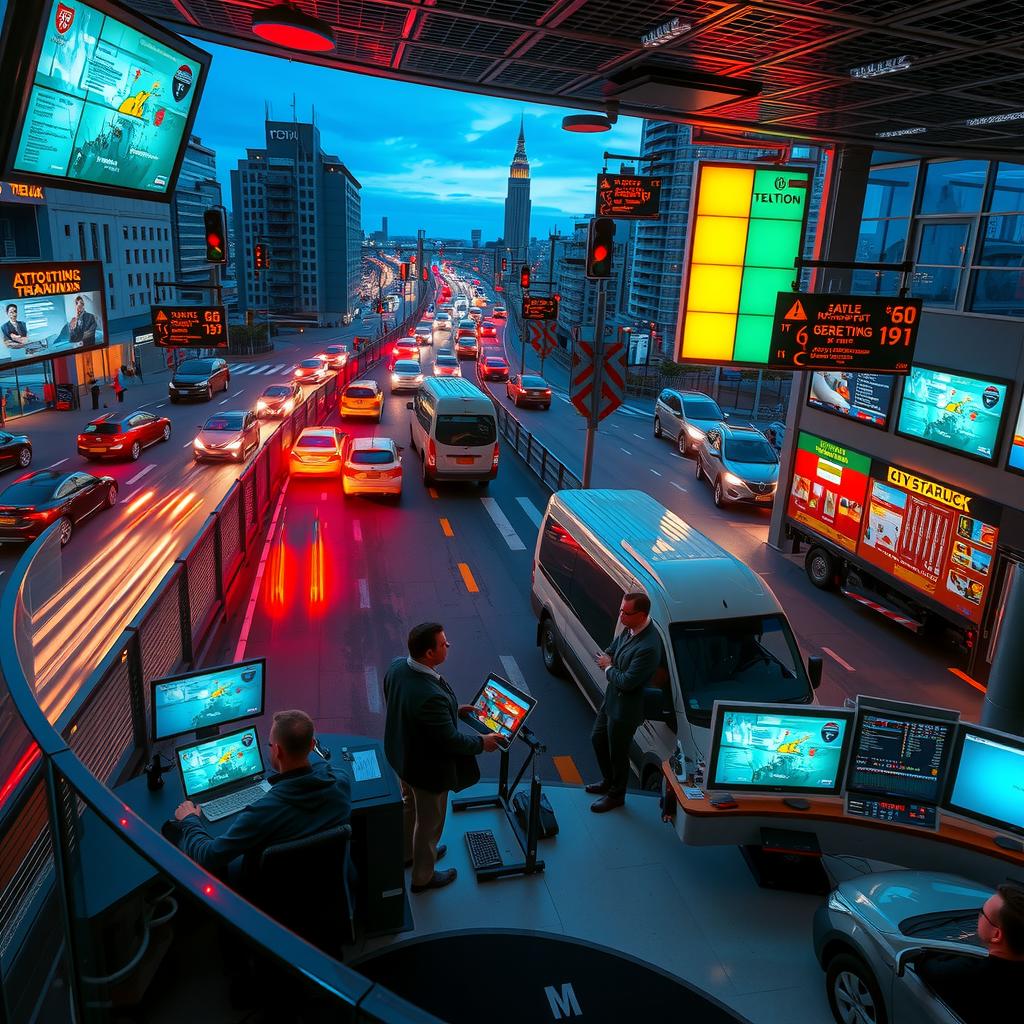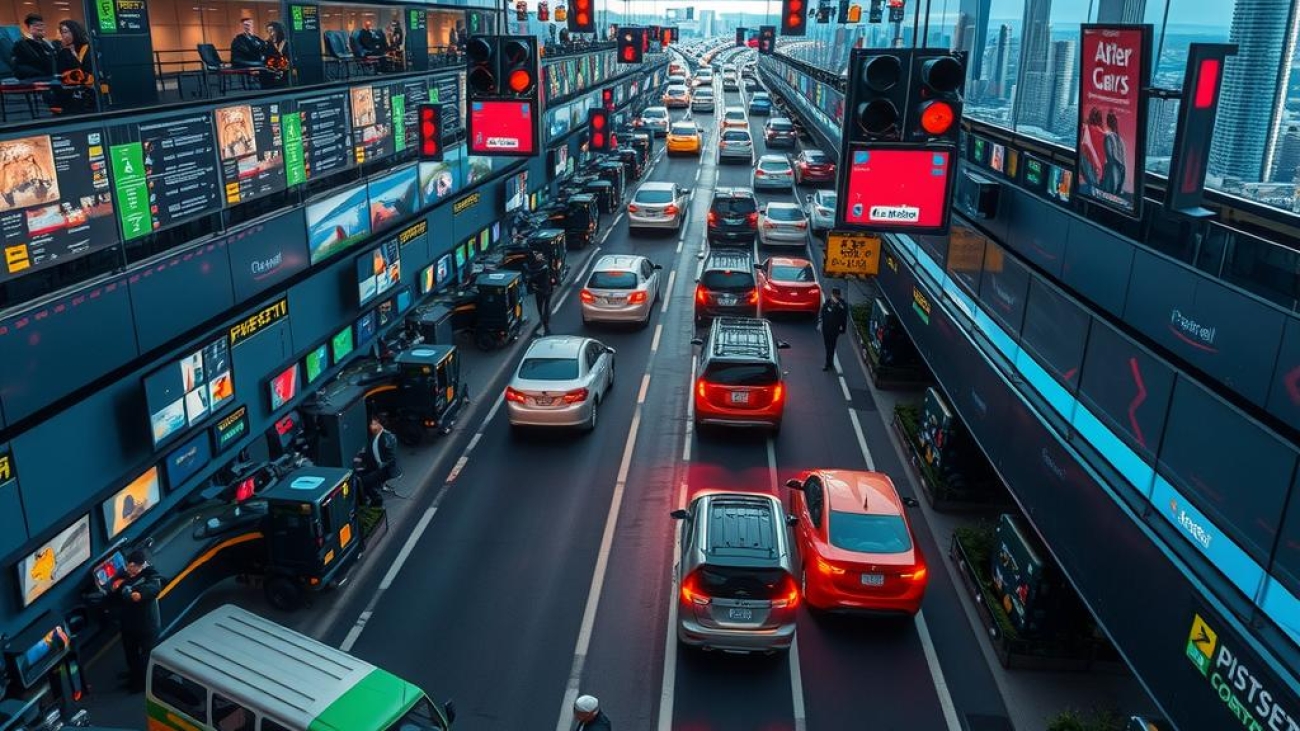In an era where urban congestion seems to be an unyielding reality, the quest for efficient traffic management becomes increasingly pressing. Have you ever found yourself frustrated in a never-ending traffic jam, wondering if there might be a more intelligent way to control the flow of vehicles? Enter Multi-agent Reinforcement Learning (MARL)—a groundbreaking approach that holds promise for revolutionizing how cities manage their transportation networks. This innovative technique leverages multiple autonomous agents working collaboratively to optimize traffic signals and patterns, thereby enhancing overall transportation efficiency.
As urban areas continue to expand and populations grow, traditional methods of traffic control are proving inadequate. The complex dynamics of modern roads require solutions that can adapt in real time and respond swiftly to changing conditions. Herein lies the core value of implementing MARL: it empowers intelligent systems capable of learning from each interaction with their environment. By simulating various scenarios and outcomes through reinforcement learning principles, these systems can discover optimal strategies for minimizing congestion while maximizing road safety.
The beauty of multi-agent reinforcement learning is not just its ability to analyze vast amounts of data but also its decentralized nature, allowing individual agents—representing different intersections or regions—to make informed decisions without relying on centralized command structures. This agility fosters resilience within urban transportation frameworks as they adapt dynamically rather than passively responding after issues arise.
This blog post delves into the nuances of implementing MARL for effective traffic control solutions. Readers will explore how this advanced methodology employs sophisticated optimization techniques that are transforming conventional approaches into responsive systems capable of anticipating challenges before they escalate. Through practical examples and case studies demonstrating successful integrations worldwide, this article aims to illuminate how leveraging MARL can lead cities toward smarter infrastructure development that prioritizes both efficiency and sustainability.
By understanding the potential impact and strategic implementation pathways offered by Multi-agent Reinforcement Learning, stakeholders—including city planners, policymakers, and researchers—can pave the way toward a future where seamless travel experiences become standard rather than exceptional occurrences. Join us as we navigate this exciting frontier in technology-driven traffic management!

Key Points:
-
Collaborative Traffic Signal Management: The implementation of Multi-agent Reinforcement Learning (MARL) allows traffic signals to work together, adapting their operations based on local conditions and the actions of neighboring signals. This cooperative interaction enhances transportation efficiency by optimizing traffic flow across intersections.
-
Self-Improving Systems for Dynamic Environments: By utilizing multi-agent reinforcement learning, intelligent systems can learn from real-time data, adjusting strategies in response to changing conditions such as accidents or construction delays. This adaptability is key to developing efficient traffic control solutions that respond effectively to evolving urban challenges.
-
Future-Ready Transportation Ecosystems: Embracing advanced technologies like Multi-agent Reinforcement Learning positions cities at the forefront of innovative traffic management. These systems not only alleviate current congestion issues but also pave the way for sustainable and safer transport networks in the future.
The integration of Multi-agent Reinforcement Learning into urban traffic management holds significant potential for improving overall transportation systems. One major area where this technology excels is through Collaborative Traffic Signal Management. In traditional settings, each traffic signal operates independently; however, with MARL, individual signals act as autonomous agents that communicate and adapt their behaviors based on both local vehicular flows and the activities of adjacent signals. Consequently, this collaborative approach leads to enhanced transportation efficiency by mitigating bottlenecks at busy intersections and ensuring a smoother transit experience for all road users.
Moreover, one of the standout advantages offered by implementing multi-agent reinforcement learning techniques lies in its ability to create self-improving systems capable of operating within dynamic environments—essentially revolutionizing how we think about effective traffic control measures. As these intelligent agents continuously gather insights from real-time data regarding changing traffic patterns or unexpected disruptions such as accidents or construction projects, they refine their decision-making processes over time without requiring constant human intervention. This level of adaptability ensures that cities can maintain optimal flow even amidst fluctuating conditions.
Finally, investing in technologies like Multi-agent Reinforcement Learning signifies a commitment toward building future-ready transportation ecosystems equipped to handle rising vehicular demands sustainably and efficiently. As urban populations increase alongside vehicle numbers—resulting in persistent congestion—a shift toward more sophisticated solutions becomes imperative. By leveraging MARL’s capabilities today, municipalities can transform traditional paradigms into smarter approaches that promise enhanced safety outcomes while reducing emissions related to prolonged idling times on congested roads.
In essence, embracing multi-agent frameworks powered by reinforcement learning will ultimately serve not just immediate needs but also lay down foundational improvements necessary for navigating tomorrow’s complex urban landscapes seamlessly.

The Urban Traffic Dilemma
Understanding the Impacts of Congestion on City Life
Urban traffic congestion presents a significant challenge for cities worldwide, leading to a myriad of persistent issues that affect both residents and local economies. As populations continue to grow in metropolitan areas, the demand for efficient transportation systems has never been more critical. However, traditional traffic control methods often fall short in alleviating these problems. Conventional approaches typically rely on fixed signal timings and manual monitoring, which can be rigid and unresponsive to real-time conditions. This inflexibility contributes to increased travel times, heightened frustration among drivers, and elevated emissions from idling vehicles—factors that further exacerbate urban air quality issues.
In recent years, advancements in technology have opened new avenues for addressing these challenges through intelligent systems designed to optimize traffic management effectively. One promising solution is Multi-agent Reinforcement Learning, which employs autonomous agents capable of learning optimal strategies based on dynamic environmental data. These intelligent systems analyze various factors such as vehicle density, weather conditions, and road incidents in real-time to adaptively manage traffic flow.
The integration of Multi-agent Reinforcement Learning into urban infrastructure could revolutionize how cities approach congestion management by enabling more responsive and adaptive traffic control mechanisms. Unlike static solutions that may become obsolete quickly due to changing patterns of urban mobility or population shifts, reinforcement learning algorithms continuously evolve their strategies based on ongoing feedback loops from the environment they operate within.
Moreover, this optimization technique not only enhances transportation efficiency but also fosters collaboration among multiple agents working simultaneously across different intersections or routes within the cityscape. Each agent can learn collectively while sharing insights with others; thus creating a holistic approach toward improving overall system performance rather than focusing solely on isolated segments of the transportation network.
As cities grapple with escalating congestion levels amid rising commuter demands and limited infrastructure expansion possibilities, embracing advanced technologies like Multi-agent Reinforcement Learning is essential for achieving sustainable growth in urban environments. By shifting towards smart traffic management solutions powered by sophisticated algorithms that prioritize flexibility over rigidity—cities can ensure smoother journeys for all users while significantly reducing their ecological footprints.
In conclusion, understanding the limitations inherent in traditional traffic control methods underscores the urgency for innovative alternatives capable of meeting contemporary demands effectively. As municipalities explore cutting-edge solutions driven by concepts like reinforcement learning applied through multi-agent frameworks—there lies an opportunity not just to mitigate current challenges but also pave pathways toward smarter living spaces conducive to future generations’ needs.
Transforming Traffic Management through Intelligent Systems
The Role of Multi-Agent Reinforcement Learning in Modern Traffic Control
In recent years, Multi-Agent Reinforcement Learning (MARL) has emerged as a groundbreaking approach to optimizing traffic management systems. By leveraging the interactions between multiple autonomous agents, MARL enables the development of adaptive strategies that respond dynamically to real-time data from urban environments. Traditional traffic control methods often rely on static algorithms that fail to account for the complexities and unpredictabilities inherent in modern transportation networks. In contrast, MARL empowers intelligent systems to learn from their surroundings and adjust their behaviors accordingly. This paradigm shift not only enhances transportation efficiency but also contributes significantly to reducing congestion and minimizing travel times.
Through sophisticated learning mechanisms, each agent in an MARL framework can evaluate its own actions while considering the impacts on others within the system. This cooperative aspect is crucial; when multiple agents—such as traffic signals or connected vehicles—communicate and share information regarding current road conditions, they create a comprehensive understanding of traffic dynamics. As stated by industry experts, “The true potential of multi-agent reinforcement learning lies in its ability to simulate realistic scenarios where agents collaborate towards common goals.” Therefore, instead of isolated decision-making processes typical in conventional approaches, intelligent systems utilizing MARL can implement optimization techniques that address both local and global traffic flow issues.
Furthermore, these advanced methodologies facilitate a proactive stance towards managing peak hours or unexpected incidents such as accidents or roadblocks. By analyzing patterns based on historical data combined with real-time inputs such as weather conditions or event schedules, MARL-driven solutions can preemptively alter signal timings or reroute vehicles efficiently without human intervention. Such adaptability is essential for modern cities striving for smart infrastructure capable of handling increasing vehicular demands while prioritizing safety and environmental sustainability.
Additionally, implementing Multi-Agent Reinforcement Learning fosters an environment conducive to continuous improvement over time; agents refine their strategies based on feedback from previous decisions—a process akin to trial-and-error learning but enhanced by collaborative exchanges among peers. This leads not only to optimized performance metrics but also cultivates resilience against fluctuating urban challenges like population growth or infrastructural changes.
As research continues into this innovative field at the intersection of artificial intelligence and transportation engineering, it becomes increasingly clear that embracing multi-agent reinforcement learning represents more than just a technological upgrade—it symbolizes a fundamental reevaluation of how society manages one of its most critical resources: mobility. In summary, harnessing the power of intelligent systems powered by MARL holds promise not just for improved efficiency but also for creating smarter cities equipped with responsive infrastructures capable of evolving alongside their inhabitants’ needs.
Advancing Urban Mobility through Collaborative Decision-Making
The integration of Multi-Agent Reinforcement Learning into existing frameworks presents transformative opportunities for urban mobility initiatives aimed at enhancing overall quality-of-life indicators related to transport accessibility and reliability.
The Future of Urban Mobility: A Technological Revolution
Envisioning Smarter Transportation Ecosystems
The integration of advanced technologies, particularly Multi-agent Reinforcement Learning (MARL), stands to revolutionize urban transportation systems. By leveraging the principles of reinforcement learning in a multi-agent context, cities can create intelligent systems that not only manage traffic flow more efficiently but also adapt dynamically to changing conditions. For instance, autonomous agents powered by MARL can communicate and collaborate in real-time, making decisions that optimize routes for both public transport and personal vehicles. This capability is crucial for alleviating congestion—a perennial challenge faced by urban planners worldwide. When each vehicle operates as an informed participant within a larger ecosystem rather than isolating itself on roads designed for solitary travel, the potential for enhanced overall efficiency becomes clear.
One significant impact of integrating Multi-agent Reinforcement Learning into urban transportation is improved safety outcomes. Intelligent systems can analyze vast amounts of data from various sources such as traffic cameras, sensors embedded in road infrastructure, and GPS signals from vehicles to predict hazards before they occur. Through continuous learning processes inherent to reinforcement learning methodologies, these systems refine their predictions over time based on historical data patterns and live interactions with other agents on the road—be it pedestrians or cyclists. As a result, proactive measures can be implemented automatically; such as adjusting signal timings at intersections or rerouting vehicles around accidents—thereby significantly reducing the risk associated with human error.
Furthermore, sustainability emerges as another vital benefit when employing Multi-agent Reinforcement Learning algorithms in traffic management strategies. With environmental concerns becoming increasingly pressing due to climate change implications stemming from pollution emitted by traditional modes of transport, optimizing traffic flows through intelligent routing can lead to decreased emissions per vehicle mile traveled. Enhanced navigation provided by MARL-driven solutions directs drivers towards less congested paths while considering factors like fuel consumption statistics associated with different road types or driving styles—promoting not just efficient travel but greener practices among users as well.
In addition to direct impacts on safety and sustainability metrics within urban landscapes lies another essential dimension: community engagement through smarter transportation options made possible via advanced algorithms including Multi-agent Reinforcement Learning. Citizens will no longer merely react passively to imposed transit structures; they will have access tools tailored specifically toward their unique mobility needs—from ride-sharing platforms utilizing collaborative filtering approaches based upon individual preferences down to local bus services adapting schedules dynamically according demand fluctuations observed across neighborhoods throughout varying times during day/week cycles.
As cities look ahead towards implementing futuristic paradigms surrounding mobility dynamics grounded firmly upon concepts rooted deeply within machine-learning frameworks like those offered through Multi-Agent Reinforcement Learning, stakeholders must actively recognize challenges posed alongside opportunities presented therein too—the need foster collaborations between governmental bodies ensuring policy support aligned efforts private sector innovation capabilities enhancing technological footprints created sustainable ecosystems ultimately enriching quality life citizens served daily basis navigating dynamic environments ever-evolving complexities woven fabric modern society demands address comprehensively moving forward together collaboratively toward brighter horizons await exploration uncharted territories awaiting discovery promise transformative changes way people move interact spaces shared collectively beyond mere convenience aspirations alone form vision future potential realized indeed!
Transformative Technologies Shaping Public Transport
Enhancing Efficiency Through Collaborative Agents
The role of public transport cannot be overstated when discussing future perspectives on urban transportation systems enhanced by Multi-Agent Reinforcement Learning (MARL) techniques. As cities expand rapidly with increasing populations requiring effective transit solutions that minimize delays while maximizing passenger comfort levels become paramount considerations influencing system designs today—not simply reactive responses anymore but proactive engagements driven insights derived complex datasets analyzed intelligently using state-of-the-art algorithmic approaches available at our disposal now! Implementing MARL allows agencies responsible managing extensive networks buses/trains/etc., harness collective knowledge amassed numerous independent entities operating concurrently across regions enabling holistic optimization strategies emerge where every single component plays integral roles interdependently contributing overall enhancements experienced passengers onboard completing journeys smoothly seamlessly connecting lives traversing increasingly interconnected world we inhabit together!
Moreover—as metropolitan areas experience shifts necessitating investments upgrading aging infrastructures—to capitalize fully transformed operational efficiencies empowered via cutting-edge technologies enabled new age architectures emerging redefine how organizations deploy assets allocate resources effectively combating inevitable strains placed existing infrastructures under pressure keeping pace growing demands effectively without compromising service reliability integrity established regions accustomed experiencing seamless connectivity previously enjoyed transitioning period inevitably challenging requires adaptability resilience showcased capabilities exhibited successfully navigating tumultuous waters lie ahead promising bright alternatives awaiting fruition realization backed firm foundation laid groundwork envisioned earlier stages outlining possibilities explored extensively here today paving pathways untold discoveries yet unfold further innovations invigorate realms encompass all facets contemporary lifestyles shared experiences enable growth flourish progress thrive sustainably perpetually advancing harmoniously intertwined exists complexity makes up essence flourishing societies filled hope dreams aspirations nurtured cultivated nourished generations come pass torch onward legacy continue enrich protect cherish values instilled generations past present shape futures unfolding revealing endless potentials beckoning forth illuminating journeys taken collectively exploring frontiers unknown inviting everyone join adventure awaits them embrace wholeheartedly!
Safety Innovations Derived From Advanced Algorithms
Real-time Decision-Making Mechanisms
An
Urban traffic congestion poses significant challenges that impact travel times, environmental sustainability, and overall quality of life. To tackle these issues effectively, cities are increasingly turning to advanced technologies such as Multi-agent Reinforcement Learning (MARL). This innovative approach enables the development of intelligent systems where autonomous agents can interact dynamically with one another while continuously adapting their strategies based on real-time data.
By implementing Multi-agent Reinforcement Learning, traffic signals and control units are empowered to operate collaboratively rather than in isolation. Each agent, representing a specific traffic signal or control unit, learns from both successful outcomes and failures within its environment. As they adjust their behaviors considering not only local conditions but also the actions taken by neighboring agents, transportation efficiency significantly improves. The cooperative nature of this strategy allows for optimized decision-making processes at intersections, thereby reducing bottlenecks and enhancing overall flow.
Moreover, the advantages of multi-agent reinforcement learning extend beyond mere operational efficiency; they encompass adaptability in response to unexpected disruptions like accidents or road construction. When autonomous agents communicate insights regarding changing traffic patterns, they collectively refine their decision-making capabilities over time. This self-improving system is crucial for effective traffic management, allowing cities to respond swiftly to evolving circumstances while ensuring smoother vehicular movement across urban landscapes.
As urban areas continue to grow and face increasing demands on their transport infrastructures, integrating technologies such as Multi-agent Reinforcement Learning becomes essential for transforming traditional approaches into smarter solutions that promise improved safety and sustainability on our roads. Continued research in this field holds great promise not only for alleviating current challenges but also for creating future-ready transportation ecosystems tailored to meet the needs of modern urban environments.
FAQ:
Q: How does Multi-Agent Reinforcement Learning improve traffic management?
A: It facilitates collaborative operation among autonomous agents representing different traffic signals or control units which enhances transportation efficiency through optimized decision-making at intersections.
Q: What role do autonomous agents play in optimizing traffic control?
A: Autonomous agents learn from real-time data about local conditions as well as interactions with neighboring agents enabling them to adaptively respond to changes in traffic patterns effectively.
Q: Can Multi-Agent Reinforcement Learning address unexpected disruptions like accidents?
A: Yes, by communicating insights about changing situations among themselves, these intelligent systems refine their strategies over time thus improving responsiveness during unforeseen events.
